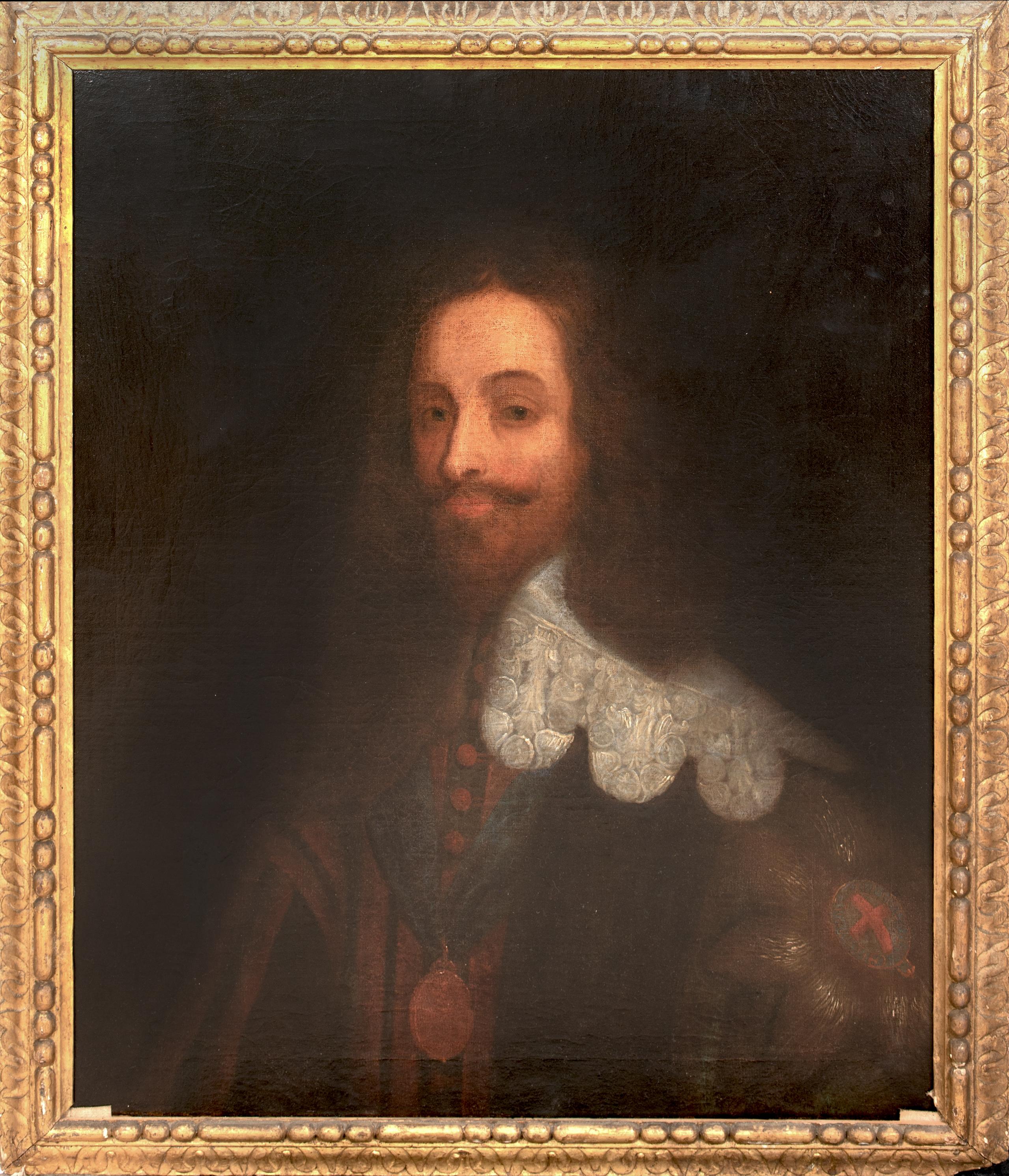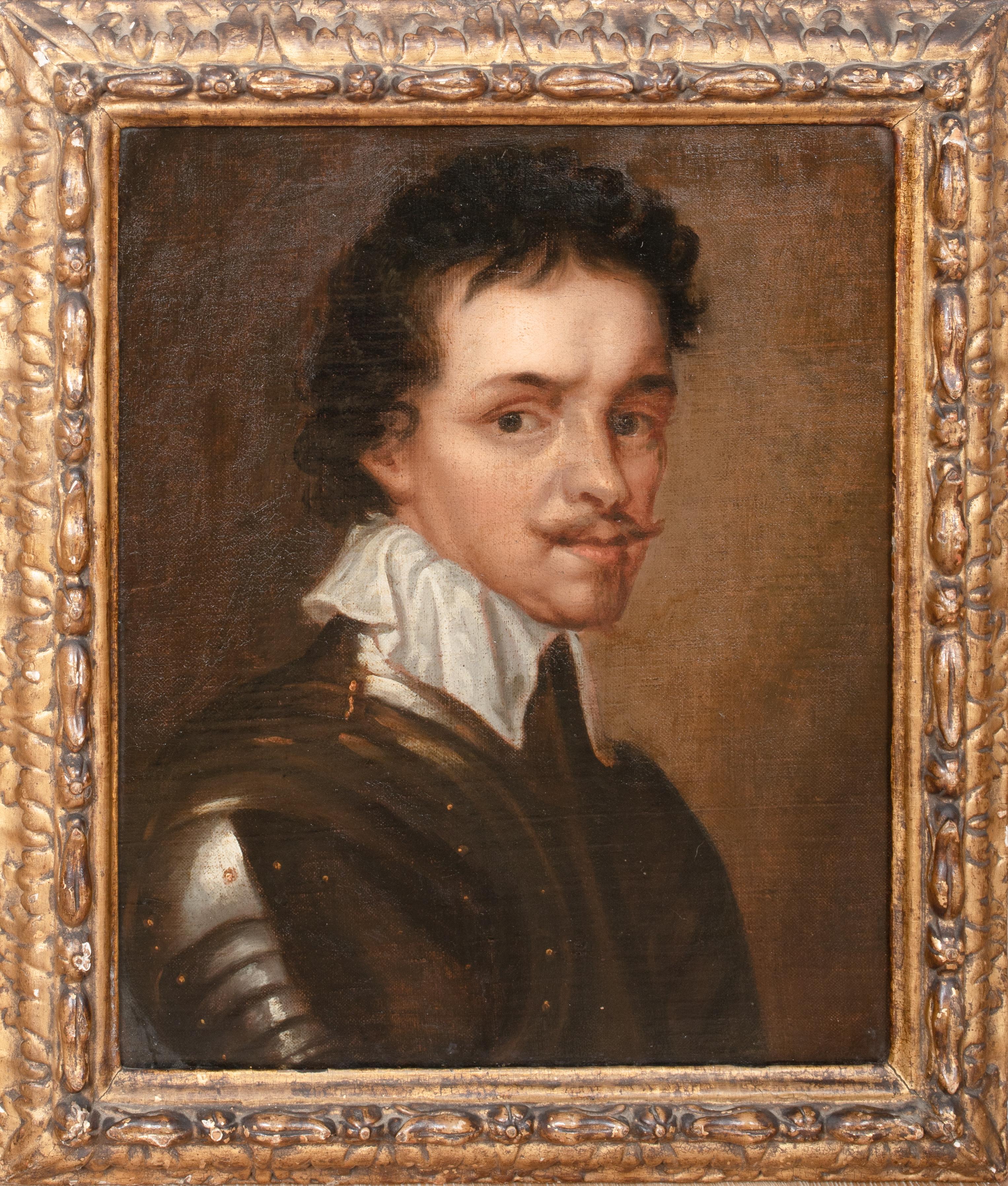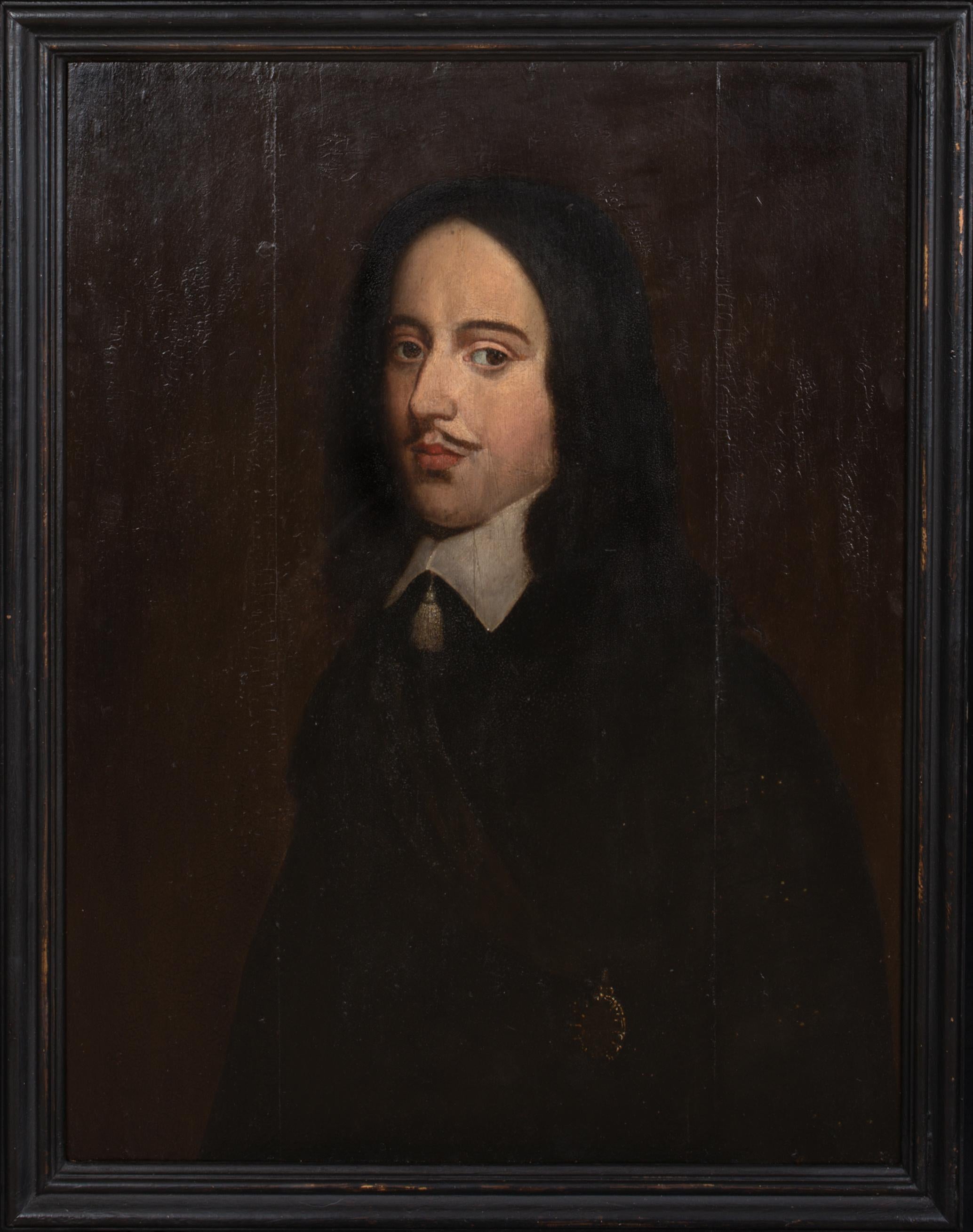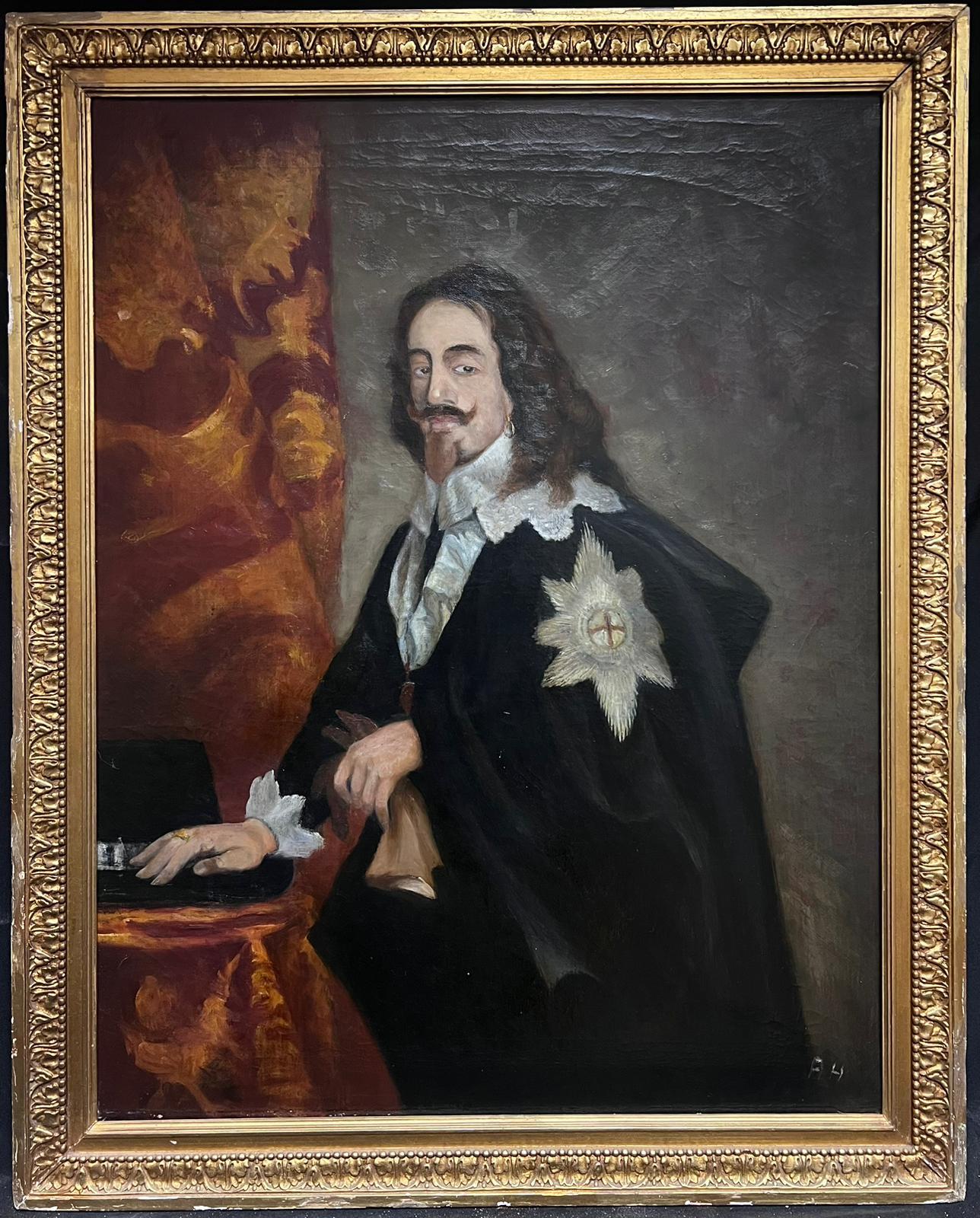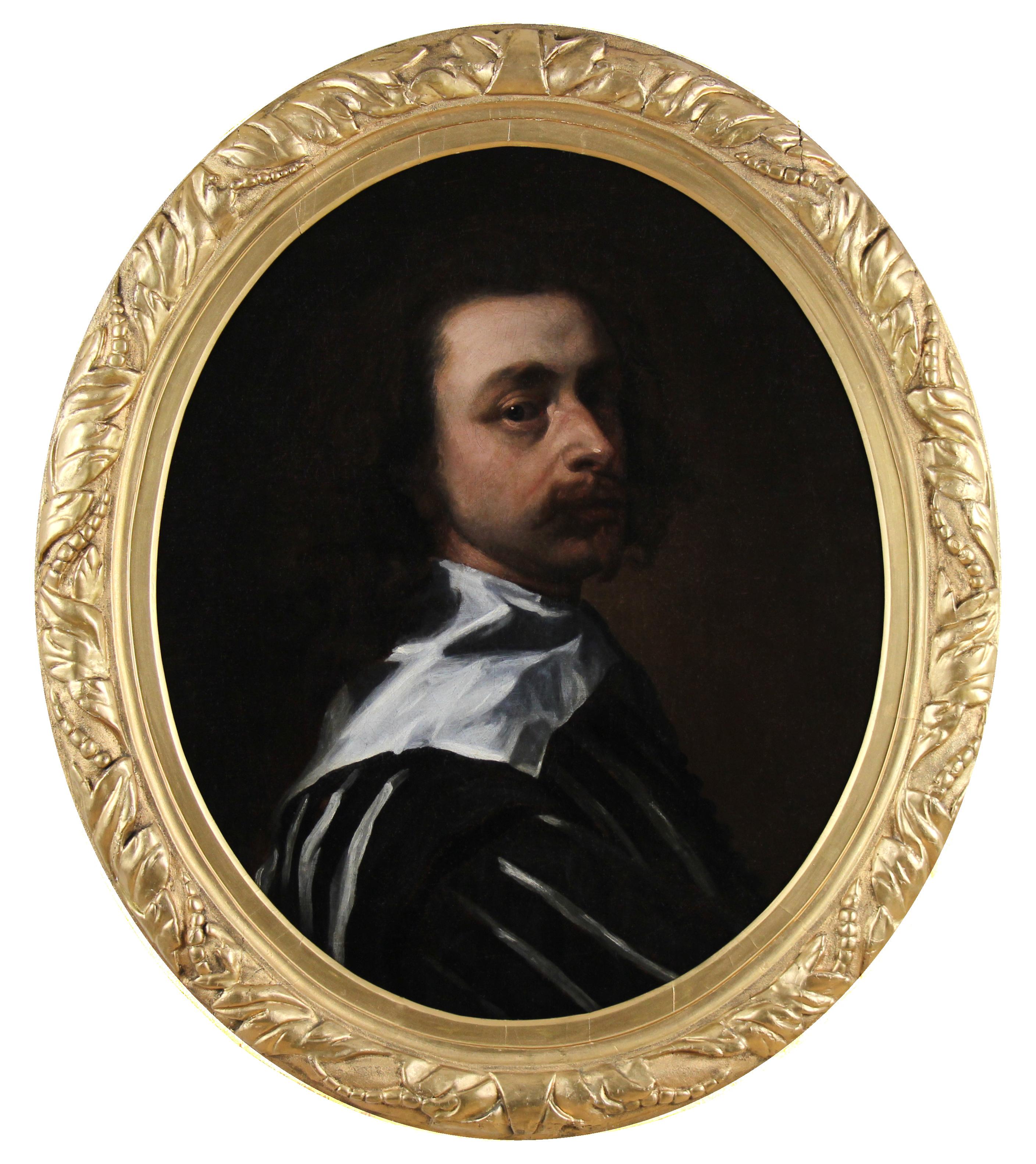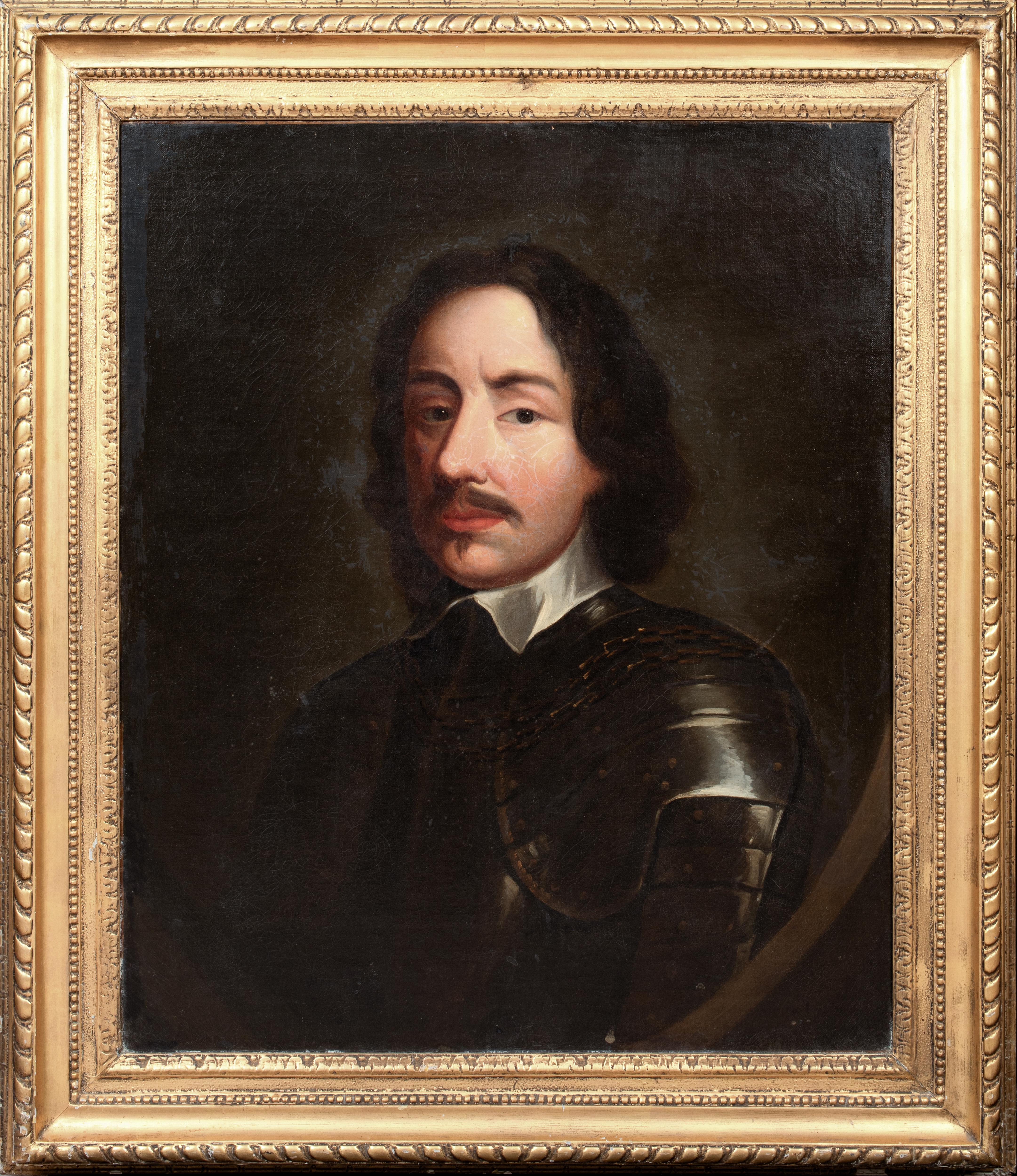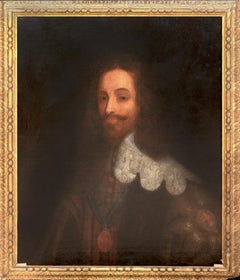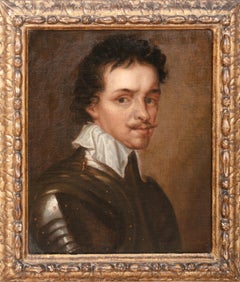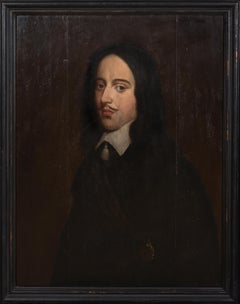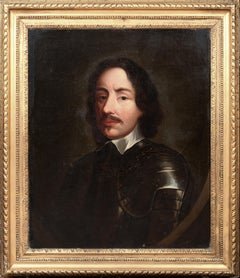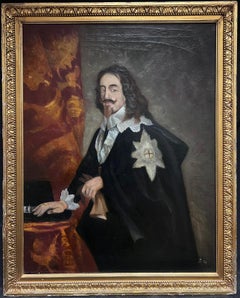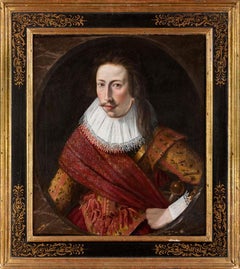Items Similar to Portrait Of King Charles I, 17th Century School of Anthony Van Dyck (1599-1641)
Want more images or videos?
Request additional images or videos from the seller
1 of 11
Portrait Of King Charles I, 17th Century School of Anthony Van Dyck (1599-1641)
$5,889.08
£4,300
€5,051.97
CA$8,259.73
A$9,058.73
CHF 4,671.97
MX$108,214.24
NOK 59,254.77
SEK 55,587.69
DKK 37,741.95
About the Item
Portrait Of King Charles I, 17th Century
School of Anthony Van Dyck (1599-1641)
Large 17th Century English School portrait of Charles I, King of England, Scotland and Ireland, oil on canvas. Somber and reflective half length portrait of Charles wearing a gold paned doublet, lace collar, silk collar and the Order of the Garter. Presented in an antique gilt frame. unsigned
The work closely resembles the portrait held at Scotty Castle, Kent, UK (attributed to Anthony Van Dyck)
Measurements: 37" x 32" framed approx
- Dimensions:Height: 37 in (93.98 cm)Diameter: 32 in (81.28 cm)
- Medium:
- Circle Of:Anthony van Dyck (1599 - 1641, Flemish)
- Period:
- Condition:
- Gallery Location:Blackwater, GB
- Reference Number:1stDibs: LU1577217053112
About the Seller
4.9
Vetted Professional Seller
Every seller passes strict standards for authenticity and reliability
Established in 2008
1stDibs seller since 2021
304 sales on 1stDibs
Typical response time: 2 hours
- ShippingRetrieving quote...Shipping from: Blackwater, United Kingdom
- Return Policy
Authenticity Guarantee
In the unlikely event there’s an issue with an item’s authenticity, contact us within 1 year for a full refund. DetailsMoney-Back Guarantee
If your item is not as described, is damaged in transit, or does not arrive, contact us within 7 days for a full refund. Details24-Hour Cancellation
You have a 24-hour grace period in which to reconsider your purchase, with no questions asked.Vetted Professional Sellers
Our world-class sellers must adhere to strict standards for service and quality, maintaining the integrity of our listings.Price-Match Guarantee
If you find that a seller listed the same item for a lower price elsewhere, we’ll match it.Trusted Global Delivery
Our best-in-class carrier network provides specialized shipping options worldwide, including custom delivery.More From This Seller
View AllPortrait Of Charles I Of England (1600-1649) Wearing The Order Of The Garter
By Anthony van Dyck
Located in Blackwater, GB
Portrait Of Charles I Of England (1600-1649) Wearing The Order Of The Garter, 17th Century
circle of Sir Antony VAN DYCK (1599-1641)
Large 17th Century English portrait of King Cha...
Category
17th Century Portrait Paintings
Materials
Canvas, Oil
Portrait Thomas Wentworth, 1st Earl of Stafford (1593-1641), 17th Century
Located in Blackwater, GB
Portrait Thomas Wentworth, 1st Earl of Stafford (1593-1641), 17th Century
Circle of Anthonius VAN DYCK (1599-1641)
Fine 17th century English School Old Master portrait of Anthonius...
Category
19th Century Portrait Paintings
Materials
Canvas, Oil
Portrait Of William II Prince Of Orange, circa 1650 Dutch School
Located in Blackwater, GB
Portrait Of William II Prince Of Orange, circa 1650
Dutch School
Large 17th Century Dutch Schoo Old Master portrait of William II Prince Of Orange, oil on panel. Early important original court portrait on an oak panel of the young prince and father of William III, his only child and later King...
Category
17th Century Portrait Paintings
Materials
Canvas, Oil
Portrait of General Henry Ireton (1611-1651) Son In Law to Oliver Cromwell
By Robert Walker
Located in Blackwater, GB
Portrait of General Henry Ireton (1611-1651) Son In Law to Oliver Cromwell, 17th Century
attributed Robert WALKER (1607-1658)
Large 17th Century portrait of General Henry Ireton, oil on canvas. Excellent quality and condition Civil War portrait...
Category
17th Century Portrait Paintings
Materials
Oil, Canvas
Portrait Of Richard Jones, 1st Earl Of Ranelagh, 17th Century SIR PETER LELY
By Sir Peter Lely
Located in Blackwater, GB
Portrait Traditionally Identified as Richard Jones, 1st Earl Of Ranelagh, 17th Century
School Of Sir Peter Lely (1618-1680)
Large 17th Century Portrait believed to be Rochard Jones...
Category
17th Century Portrait Paintings
Materials
Canvas, Oil
Portrait Of William Yorke (1609-1666), 17th Century
Located in Blackwater, GB
Portrait Of William Yorke (1609-1666), 17th Century
circle of Edward Bower (fl. 1635 – 1667)
Fine large 17th Century English Master portrait of William...
Category
17th Century Portrait Paintings
Materials
Canvas, Oil
You May Also Like
King Charles 1st Antique Oil Painting Portrait of Famous British Monarch
Located in Cirencester, Gloucestershire
King Charles I
British artist, early 20th century
signed with initials
oil on canvas, framed
framed: 36 x 29 inches
canvas: 32 x 26 inches
provenance: p...
Category
Early 1900s Old Masters Portrait Paintings
Materials
Oil, Canvas
Oil On Canvas Self Portrait of the artist Sir Anthony Van Dyck 18Th c
Located in Gavere, BE
"Oil On Canvas Self Portrait After Sir Anthony Van Dyck"
Follower of Sir Anthony van Dyck (Flemish painter, 1599-1641), Self portrait Oil on canvas (doubled),
Probably end 18th centu...
Category
Late 18th Century Baroque Figurative Paintings
Materials
Gold Leaf
Portrait of an Officer, Cornelius Johnson, 17th Century Old Masters
By Cornelius Johnson
Located in London, GB
Circle of Cornelius Johnson
Circa 1620’s
Portrait of a Officer
Oil on canvas
Image size: 28 x 24 inches
Period style hand made frame
Provenance
Private European Estate
This striking portrait dates to around 1620, as you can see from the images of the sash the detail is very high. The sash is decorated with gold thread and would have cost a small fortune at the time. Sashes were originally developed for a military function (making officers more visible for their men during combat), but soon became a primarily male fashion...
Category
Early 17th Century Old Masters Portrait Paintings
Materials
Oil
Portrait of William Herbert, 3rd Earl of Pembroke, Early 17th Century Portrait
Located in London, GB
English School, (circa 1600)
Portrait of William Herbert, 3rd Earl of Pembroke
Oil on panel, oval
Image size: 29¼ x 23⅞ inches
Painted wooden frame
Provenance:
176, Collection of Francis Greville, 1st Earl of Warwick.
The Trustees of the Lord Brooks’ Settlement, (removed from Warwick Castle).
Sotheby’s, London, 22nd March 1968, lot 81.
Painted onto wooden panel, this portrait shows a dark haired gentleman in profile sporting an open white shirt. On top of this garments is a richly detailed black cloak, decorated with gold thread and lined with a sumptuous crimson lining. With the red silk inside it’s all very expensive and would fall under sumptuary laws – so this is a nobleman of high degree.
It’s melancholic air conforms to the contemporary popularity of this very human condition, evident in fashionable poetry and music of the period. In comparison to our own modern prejudices, melancholy was associated with creativity in this period.
This portrait appeared in the earliest described list of pictures of Warwick castle dating to 1762. Compiled by collector and antiquary Sir William Musgrave ‘taken from the information of Lord & Lady Warwick’ (Add. MSS, 5726 fol. 3) is described;
‘8. Earl of Essex – an original by Zuccharo – seen in profile with black hair. Holding a black robe across his breast with his right hand.’
As tempting as it is to imagine that this is a portrait of Robert Devereux, the 2nd Earl Essex, we might take this with a pinch of salt. Its identification with this romantic and fatal Elizabethan might well have been an attempt to add romance to Warwick Castle’s walls. It doesn’t correspond all that well with Essex’s portraits around 1600 after his return from Cadiz. Notably, this picture was presumably hung not too far away from the castle’s two portraits of Queen Elizabeth I. The first, and undoubtedly the best, being the exquisite coronation portrait that was sold by Lord Brooke in the late 1970s and now hangs in the National Portrait Gallery. The second, described as being ‘a copy from the original at Ld Hydes’, has yet to resurface.
The portrait eventually ended up being hung in the State Bedroom of Warwick Castle.
Archival documents present one other interesting candidate. The Greville family’s earliest inventory of paintings, made in 1630 at their home Brooke House in Holborn, London, describes five portraits of identified figures. All five belonged to the courtier, politician and poet Sir Fulke Greville (1554-1628), 1st Baron Brooke, and were hung in the ‘Gallerie’ of Brooke House behind yellow curtains. One of them was described as being of ‘Lord of Pembrooke’, which is likely to have been William Herbert (1580-1630), 3rd Earl of Pembroke. William was the eldest son of Greville’s best friend’s sister Mary Sidney, and was brought up in the particularly literary and poetically orientated household which his mother had supported. Notably, the 3rd Earl was one of the figures that Shakespeare’s first folio was dedicated to in 1623.
The melancholic air to the portrait corresponds to William’s own pretensions as a learned and poetic figure. The richness of the robe in the painting, sporting golden thread and a spotted black fabric, is indicative of wealth beyond that of a simple poet or actor. The portrait’s dating to around the year 1600 might have coincided with William’s father death and his own rise to the Pembroke Earldom. This period of his life too was imbued with personal sadness, as an illicit affair with a Mary Fitton had resulted in a pregnancy and eventual banishment by Elizabeth I to Wilton after a short spell in Fleet Prison. His illegitimate son died shortly after being born. Despite being a close follower of the Earl of Essex, William had side-stepped supporting Devereux in the fatal uprising against the Queen and eventually regained favour at the court of the next monarch James I.
His linen shirt is edged with a delicate border of lace and his black cloak is lined on the inside with sumptuous scarlet and richly decorated on the outside with gold braid and a pattern of embroidered black spots.
Despite the richness of his clothes, William Herbert has been presented in a dishevelled state of semi-undress, his shirt unlaced far down his chest with the ties lying limply over his hand, indicating that he is in a state of distracted detachment. It has been suggested that the fashion for melancholy was rooted in an increase in self-consciousness and introspective reflection during the late 16th and early 17th centuries.
In contemporary literature melancholy was said to be caused by a plenitude of the melancholy humor, one of the four vital humors, which were thought to regulate the functions of the body. An abundance of the melancholia humor was associated with a heightened creativity and intellectual ability and hence melancholy was linked to the notion of genius, as reflected in the work of the Oxford scholar Robert Burton, who in his work ‘The Anatomy of Melancholy’, described the Malcontent as ‘of all others [the]… most witty, [who] causeth many times divine ravishment, and a kind of enthusiamus… which stirreth them up to be excellent Philosophers, Poets and Prophets.’ (R. Burton, The Anatomy of Melancholy, London, 1621 in R. Strong, ‘Elizabethan Malady: Melancholy in Elizabethan and Jacobean Portraits’, Apollo, LXXIX, 1964).
Melancholy was viewed as a highly fashionable affliction under Elizabeth I, and her successor James I, and a dejected demeanour was adopted by wealthy young men, often presenting themselves as scholars or despondent lovers, as reflected in the portraiture and literature from this period. Although the sitter in this portrait is, as yet, unidentified, it seems probable that he was a nobleman with literary or artistic ambitions, following in the same vain as such famous figures as the aristocratic poet and dramatist, Edward de Vere...
Category
Early 17th Century Old Masters Portrait Paintings
Materials
Oil, Wood Panel
Framed Oil On Canvas Of A British Lord After Van Dyck
Located in Essex, MA
By repute the Earl of Norwich. Seated with attendant tending to his scarf. In a French period empire giltwood frame.
Category
Antique 17th Century English Paintings
Materials
Canvas
Portrait Philip V King Rigaud Paint Oil on canvas 17/18th Century Old master Art
Located in Riva del Garda, IT
Hyacinthe Rigaud (Perpignan 1659 - Paris 1743) Circle
Portrait of Philip V, King of Spain (Versailles 1683 - Madrid 1746)
Oil on canvas
72 x 59 cm - framed 87 x 74 cm.
The painting examined here, depicting King Philip V of Spain (Perpignan 1659 - Paris 1743), is to be placed in the circle of the painter Hyacinthe Rigaud (Perpignan 1659 - Paris 1743), one of the most significant portrait painters of his time and a great interpreter of the French school.
This is a work of excellent pictorial quality: note the rendering of the facial features and the sharpness of the contours emphasised by the light. The face is characterised by chiaroscuro passages that verisimilarly reproduce light and its effects, rendered with great skill.
Philip V wears a black satin costume with a sword at his side, he wears the stiff white Spanish collar and at the same time wears the blue sash of the Order of the Holy Spirit and the collar of the Habsburg Order of the Golden Fleece: this bringing together of the two main orders of France and Spain announced the possibility of a union between the two crowns.
In Spanish costume, this effigy is nevertheless fully in line with the French tradition of ceremonial portraiture, also testifying to the renewal that Rigaud had brought about, particularly through the relationship between the character and the splendour of the decoration.
The work is inspired, reworked in a reduced format to make it suitable for a private clientele, by the large painting that Rigaud made for the sovereign around 1700, today conserved in the Louvre, reproduced by the same workshop in numerous other versions.
The account books...
Category
17th Century Old Masters Paintings
Materials
Oil
$7,419 Sale Price
20% Off
